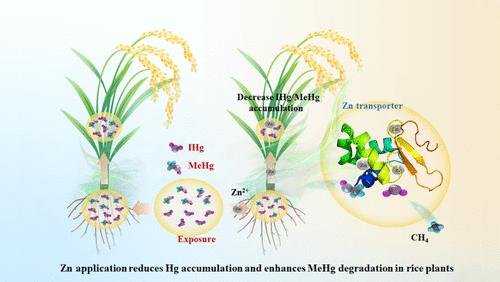减轻汞在水稻中的积累并促进甲基汞的降解:锌汞分子水平拮抗作用的启示
IF 6.2
1区 农林科学
Q1 AGRICULTURE, MULTIDISCIPLINARY
引用次数: 0
摘要
锌作为一种必需元素,具有保护水稻免受汞(Hg)毒性侵害的潜力。然而,锌和汞在水稻中的拮抗作用及其机理仍然未知。本研究提出了一种应用锌来减轻水稻汞积累和毒性的可行策略,并揭示了其潜在的分子机制。研究结果表明,补锌能显著降低水稻对 IHg 和 MeHg 的吸收和迁移,从而减轻汞的植物毒性。特别是,锌大大减轻了汞对水稻的氧化损伤,这归因于汞和锌在根部的重新分布以及锌竞争谷胱甘肽上的结合位点。Zn2+ 和 HgCH3+ 共同结合在锌转运体的同一活性位点上,可促进最高占位分子轨道(HOMO)水平电荷密度分布较高区域的转移。这一过程有利于质子攻击 Hg-C 键,从而促进水稻中甲基汞的去甲基化。通过阐明锌、IHg 和甲基汞在水稻中相互作用的分子机制,这项研究为制定有效的战略提供了新的见解,从而在提高作物中锌含量的同时降低汞风险,进而加强食品安全。本文章由计算机程序翻译,如有差异,请以英文原文为准。

Mitigating Mercury Accumulation and Enhancing Methylmercury Degradation in Rice: Insights from Zinc–Mercury Antagonism at Molecular Levels
Zn as an essential element has the potential to protect against mercury (Hg) toxicity in rice. However, the antagonistic effects between Zn and Hg in rice and their mechanisms remain unknown. This study proposed a promising strategy for Zn application to mitigate Hg accumulation and toxicity in rice and revealed the underlying molecular mechanisms. The findings revealed that Zn supplementation significantly reduced the uptake and transportation of both IHg and MeHg in rice, thereby alleviating Hg phytotoxicity. In particular, Zn profoundly mitigated Hg-induced oxidative damage to rice, which was attributed to the redistribution of Hg and Zn in the root and Zn competing for binding sites on glutathione. The co-binding of Zn2+ and HgCH3+ within the same active sites of Zn transporters can promote the transfer of regions with a high charge density distribution at the highest occupied molecular orbital (HOMO) level. This process facilitates proton attack on the Hg–C bond, thereby enhancing MeHg demethylation in rice. By elucidating the molecular mechanisms of Zn, IHg, and MeHg interactions in rice, this study offers new insights for developing efficient strategies to mitigate Hg risks while boosting the Zn content in crops, thereby fortifying food safety.
求助全文
通过发布文献求助,成功后即可免费获取论文全文。
去求助
来源期刊
CiteScore
9.90
自引率
8.20%
发文量
1375
审稿时长
2.3 months
期刊介绍:
The Journal of Agricultural and Food Chemistry publishes high-quality, cutting edge original research representing complete studies and research advances dealing with the chemistry and biochemistry of agriculture and food. The Journal also encourages papers with chemistry and/or biochemistry as a major component combined with biological/sensory/nutritional/toxicological evaluation related to agriculture and/or food.

 求助内容:
求助内容: 应助结果提醒方式:
应助结果提醒方式:


